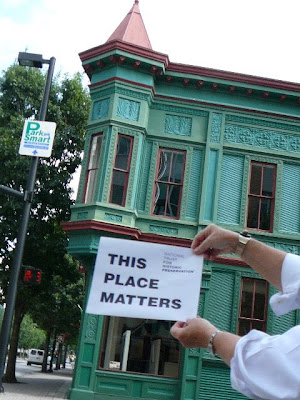
The City of Winter Park has some wonderful architecture from the 20th century like Casa Feliz and the Spanish Revival buildings on the Rollins College campus. A fairly affluent community, Winter Park has the means to preserve historic structures so they can be enjoyed by future generations. The city doesn't seem to have much regard, however, for structures built in the mid-twentieth century.
First, they demolished the wonderful Langford Resort Hotel, Central Florida's most glamorous resort for many years. Now in an effort to create more park space, they are considering tearing down the mid-century modern post office built in 1965. The Orlando Sentinel published an article last week about the proposed expansion of Central Park, the city's wonderful stretch of green running most of the length of Park Avenue, parallel to the railroad tracks. The article focuses mainly on the fact that $4 million dollars would need to be raised to expand the park, and "professional fundraising consultants and media relations people" have been hired to make this happen.
The part of the article that got my attention was this: "relocating the New York Avenue post office to the northern edge of the park and moving the postal distribution center out of the downtown core." I got the impression from reading minutes from the Winter Park City Commission meeting in August, that city leaders have embraced the idea of moving the customer service portion of the post office to somewhere else near Park Avenue. As the Postal Service nationwide struggles to remain viable, and post offices are are used less and less, this is not surprising.

The most interesting aspect of this particular post office are the murals on two sides of the building. I don’t know if you would call them mosaics because they appear to be painted rock. The wonderful abstract design is very typical mid-century modern and was created Tampa area artist Joe Testa-Secca. The winner of the Best of Show award at the Winter Park Sidewalk Art Show in ‘65, Testa-Secca also has completed murals on the University of South Florida campus.
 This decoration on the Department of Chemistry at USF is described this way" bas relief murals (symbolizing "Man's relationship to man") created by Joe Testa-Secca."
This decoration on the Department of Chemistry at USF is described this way" bas relief murals (symbolizing "Man's relationship to man") created by Joe Testa-Secca."Here is a brief bio of the artist I found online: “Born in 1928, Tampa native and veteran of the Korean Conflict, Joe Testa-Secca earned his undergraduate degree from the University of Tampa, an M.F.A. from the University of Georgia and completed post-graduate work in Fine Arts at the University of Iowa. Joe Testa-Secca is currently working as Professor Emeritus with the University of Tampa. His honors and awards include exhibitions at the Museum of Contemporary Crafts in NYC, the Delgado Museum, and the U.S. Art in the Embassies Program to name a few, including 35 one-man exhibitions during his entire career. His work has been featured in many permanent collections across the country.”
When I contacted the public relations firm in charge of raising the money, they offered very little information. While I understand that a full service post office may no longer be necessary in Winter Park, (an online comment on the Sentinel’s story said 52% of respondents favored keeping the Post Office), I wonder if they’d consider somehow incorporating the murals into the new park space. They are a wonderful time capsule into the aesthetics of the 1960s and would make a great backdrop or even a focal point for an outdoor area. Overall Central Florida has done a lousy job of preserving resources from that era, and while many don’t appreciate that aesthetic now, perhaps future generations might enjoy it in the same manner we love the architecture of James Gamble Rogers II today.



































